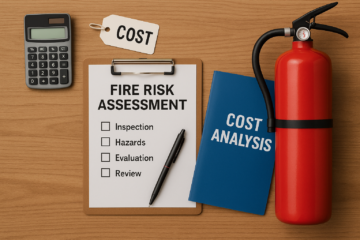—A plain-English guide for facilities managers, landlords, and curious staff across the UK, from Dundee mills to Bristol co-working hubs.*
Why timing matters
Last March in Hackney, a graphic-design studio moved three desks, added a 3-D printer, and stacked boxes of paper near a heater. Nobody updated the fire file. Three months later, the printer’s power pack overheated, filling the top floor with smoke. The fire marshal asked one question: “When did you last review the assessment?”
Nobody knew. The smoke damage cost £ 22,000.
That single question is the heart of fire risk assessment frequency. Let’s answer it in four short sections, using simple words and real-life nudges.
1 The statutory wording (what the law really says)
The Regulatory Reform (Fire Safety) Order 2005 tells every “Responsible Person” to:
“Review the fire-risk assessment regularly” and “if there is reason to suspect it is no longer valid.”
Notice two things:
- The word “regularly” is fuzzy.
- The phrase “reason to suspect” covers almost any change.
Guidance from the Home Office and the Building Safety Act 2022 narrows it down:
- Review at least once every 12 months.
- Record a full new assessment every 5 years.
- Update straight away after a major change.
Insurance underwriters now echo those triggers. Some want the review letter on their desk at renewal time. Miss it and you may pay a higher premium.
Need a deeper dive on who the Responsible Person is? See our post “Fire-Risk Assessment for Blocks of Flats: A Resident-Friendly Guide.” It breaks the role down with tea-break examples.
2 Change triggers—three buckets: building, people, process
Think of your site as a table with three legs. If any leg shifts, the table wobbles. That wobble is your cue to check the fire risk assessment frequency.
2.1 Building changes
- Layout tweaks—new partitions in a law firm on Chancery Lane block smoke paths.
- Plant upgrades—extra lithium battery store in a warehouse near Leeds ring road.
- Temporary works—scaffolding that blocks an exit.
- Fire-safety kit swap—old panel replaced with a shiny addressable unit.
- Weather damage—storm pulls the roof vent loose; smoke venting is now suspect.
2.2 People changes
- Head-count jump—tech start-up in Manchester doubles staff after a funding round.
- New shift pattern—night crew packing parcels in Milton Keynes need fresh escape plans.
- Mobility needs—intern joins using a wheelchair; evac routes must suit.
- Contractors on site—fit-out team soldering cables for three weeks.
2.3 Process changes
- Hot-work permits—welding now done in-house.
- Storage type—switch from paper to aerosols.
- New tech—crypto-mining rigs pump heat 24/7 in a converted loft.
- Seasonal add-ons—Christmas tree lights, patio heaters on a roof bar.
Every time one of those bullets fires, ask:
“Has our risk changed? If yes, review today.”
A small review means reading the last report, walking the route, and adding notes. Big changes may need a new FRA from a competent assessor.
3 CPD cycles—linking pro learning with safe timing
Most risk consultants hold IFE or FIA memberships. Their continuing professional development (CPD) program runs on an annual cycle:
- Gold rule: learning hours ≈ 20 per year.
- Perfect pairing: carry out at least one live review per client each year.
- Benefit to you: fresh eyes and current code updates.
Ask your assessor for their CPD log. If they haven’t logged hours this year, their advice may be stale.
Staff CPD counts too. Train fire wardens every 12 months. When they refresh, walk the assessment together. Two birds, one slot in the diary.
4 Example review timetable—plug-and-play
Below is a sample plan used by a 4-storey office in Guildford. Swap months to suit your lease and holiday rhythm.
| Month | Trigger / Task | Who | Note |
|---|---|---|---|
| January | Full fire drill | H&S lead | Use new staff list |
| February | Document review meeting | RP + assessor | Check last year’s action log |
| March | Minor layout change (new pods) | FM | Quick walk, update plan |
| April | Review FRA (12-month) | External assessor | Issue signed letter |
| May | CPD seminar on lithium batteries | Assessor | Share slides with staff |
| June | Summer BBQ heaters added | Catering lead | Add to risk log |
| September | Night shift starts | FM | Update PEEP list |
| October | Storm damage to roof vents | FM | Immediate review |
| December | Festive lights audit | Fire warden | Remove dodgy cables |
Key takeaways
- Annual review slots live BEFORE busy periods.
- Big changes (roof vents) cause instant reviews.
- All notes feed back to the master FRA.
This table pairs well with our article “Office Fire-Risk Assessment: 7 Hazards You’re Probably Overlooking.” Cross-link them to keep your documentation tight.
Putting it all together—simple checklist
- Mark a yearly date—tie it to insurance renewal.
- Watch the three buckets—building, people, process.
- React same day when any bucket tips.
- File the update—digital PDF saved to cloud.
- Tell the team—email the change, pin a fresh escape map.
- Book CPD-linked reviews so your assessor stays sharp.
Do that and your fire risk assessment frequency will never slip.
Quick FAQ
Can I wait five years if nothing changes?
No. Law says to review regularly. An annual check is the accepted norm.
Our office is tiny. Do we still need yearly reviews?
Yes—even a two-room unit above a shop in Brighton sees staff turnover and seasonal kit.
What counts as a ‘review’?
A signed note that you read the FRA, walked the site, and confirmed it is still valid—or listed fixes.
Final thought
Fire risk isn’t a one-off test; it’s a heartbeat. Each move, each hire, each gadget can skip that beat. Keep your review rhythm steady, and you’ll sleep easily.
Need a Fire Risk Assessment? Call All Well on 020 3920 9617.
Ask for our free Frequency Trigger Cheat-Sheet and see also our guide on BS 5839 Fire Alarm Inspections Explained for alarm-check pointers that slot neatly into your yearly review.


